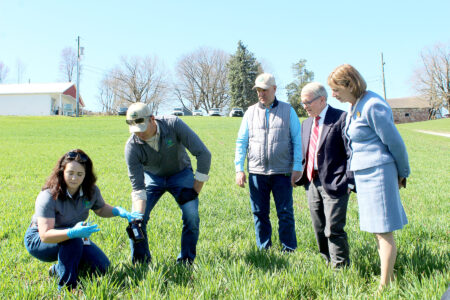
ARTICLE: ODA takes plant tissue samples


ODA takes plant tissue samples
NEW WATERFORD — The Ohio Department of Agriculture (ODA) turned its agricultural plant tissue sampling plan into a process on Monday, as the ODA collected plant tissue samples from Lindsay’s Pine Hill Jersey Farm in New Waterford.
The sampling was the first for ODA, which established a procedure in partnership with Ohio State University, to sample and analyze plant tissue materials in Columbiana County to address concerns of the local agricultural community following the Norfolk Southern Railroad train derailment.
Ohio Department of Agriculture Director Brian Baldridge was at the New Waterford farm along with Ohio Gov. Mike DeWine as the first samples were taken.
“What we are doing is taking a sample of plant tissue and testing for a focused list of semi-volatile organic compounds,” Baldridge said. “I know there are a lot of questions about the upcoming crop season and this tissue sampling will help answer some of those questions.”
The plant tissue sampling and testing follows soil sampling that began on March 9 in and around East Palestine. The soil testing was conducted at various agricultural, residential and recreational areas around the village.
Results have shown levels of toxins in the soil have not exceeded safe levels.
“We’ve already been testing the soil and so far those results have been good,” DeWine said. “The testing of the plant tissue is just another step. The farmers need to know that their crops are safe and that is why the ODA is here.”
The result of the plant tissue testing is expected to take three weeks. Baldridge said that the tissue testing would not be recurring. He said additional sampling would be only taken and tested if tests of Monday’s samples return unfavorable results.
Scott Lindsay, whose family has owned Lindsay’s Pine Hill Jersey Farm for over three quarters of a century, feels confident his crops are safe. Although he could see the toxic cloud from his property when the control burn was conducted in East Palestine, his land sits downwind of East Palestine.
“Honestly, we could see it, but we couldn’t really smell it,” he said. “I really feel like we were fortunate, but I wanted to take advantage of the opportunity to have the plant tissue tested to put the public’s worries at ease. Of course, we want to make sure that the crops are safe and we believe they are.”
The ODA plant health collected samples of growing crops. Winter wheat, which is typically planted at the end of September through November and harvested in summer, was the crop sampled at Lindsay’s farm. The ODA also plans to collect samples of pasture grasses, malting barley, and forage covers. Sampling will be conducted at locations within a five-mile radius of the train derailment site.
ODA and OSU will release results to the landowners before publicly releasing their findings.